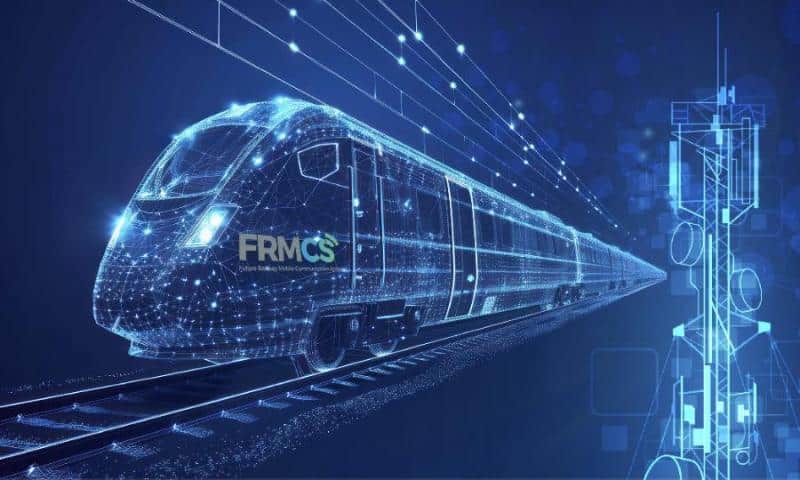The FRMCS over 5G course offers a comprehensive technical journey into the evolution of railway communication systems as they transition from legacy GSM-R to a future-ready, 5G-based architecture. This training is designed to equip telecom professionals, railway engineers, and system integrators with the knowledge needed to understand, plan, and implement the Future Railway Mobile Communication System (FRMCS) in alignment with 3GPP standards and industry requirements.
The course begins with a strategic overview of why the shift from GSM-R is essential—highlighting the growing needs for high-speed connectivity, low-latency communication, and scalable services in modern rail operations. Participants are then guided through the end-to-end FRMCS system, with a strong focus on 5G architecture, QoS mechanisms, and service-based interactions that enable mission-critical communication in fast-moving railway environments.
5G FRMCS Training
- Created by 5GWORLDPRO
- Last updated 06/2025
- 51,789 students enrolled

VIRTUAL CLASSROOM TRAINING

CLASSROOM TRAINING

This course includes:
- 2 Days Training
- Downloadable resources
- Full lifetime access
- Access on mobile and TV
- Certificate of Completion
Learning Path
- Limitations of GSM-R: spectrum constraints, circuit-switched dependency, and limited data capacity.
- Drivers for change: automation, predictive maintenance, high-speed data needs, and ERTMS evolution.
- FRMCS vision and role in supporting digital railways and autonomous train operations.
- Key stakeholders and global initiatives backing FRMCS development.
- Introduction to key use cases: train-to-ground video streaming, real-time diagnostics, and remote driver communications.
- Introduction to 5G system design and evolution from LTE.
- Core components of the 5G architecture relevant to FRMCS (AMF, SMF, UPF, PCF).
- SBA (Service-Based Architecture) and RESTful API exposure for railway applications.
- Functional overview of the IMS system and its role in delivering voice/video over IP.
- C-RAN and gNB-DU/ gNB-CU split concepts for centralized rail deployments.
- Detailed registration signaling flow for train-mounted UEs.
- How PDU sessions are set up for MCPTT, MCData, and MCVideo.
- Deep dive into 5QI values, ARP levels, and GBR/non-GBR mapping for rail services.
- Dynamic QoS modification during handovers and emergency broadcasts.
- Network slicing tailored to rail functions: operational, safety, and passenger slices.
- Authentication, authorization, and integrity assurance in FRMCS.
- Frequency bands allocated for FRMCS (e.g., 874–876 MHz, 915–917 MHz).
- Duplexing modes: TDD vs. FDD for rural and dense metro corridors.
- Overview of 5G NR numerology and its impact on high-speed rail mobility.
- Frame structure and slot configuration recommendations for latency-sensitive rail apps.
- Practical coexistence strategies for GSM-R and FRMCS during the transition phase.
- FRMCS application layer: dispatcher systems, CCTV uplink, data acquisition.
- Key interface points: APIs between NEF and third-party control systems.
- Network exposure strategies for predictive analytics, monitoring platforms, and emergency alerts.
- How to expose real-time location, service availability, and diagnostic data to control centers.
- Introduction to MEC (Multi-access Edge Computing) and edge placement in rail environments.
- Architecture of MCx services and how they fulfill railway safety requirements.
- Setup of group communication for emergency and daily operational calls.
- Proximity-based communication using ProSe in tunnel and rural conditions.
- Multicast and broadcast (MBS) to disseminate information to multiple rail subsystems.
- Integration of MCPTT with emergency braking, train control, and alerting systems.
- Migration planning from GSM-R to FRMCS: phased vs. overlay models.
- Interoperability testing, pilot project frameworks, and KPI definition.
- Performance monitoring: jitter, latency, packet loss benchmarks for mission-critical flows.
- Real-time network adaptation to rail mobility patterns (handover frequency, signal blocking zones).
- Ensuring redundancy and availability in harsh environments.
- Review of 3GPP Release 17/18 features relevant to FRMCS.
- Integration with 6G and beyond: ultra-reliable, low-latency evolution.
- AI/ML in rail communications: anomaly detection, autonomous maintenance triggers.
- Edge intelligence and orchestration of rail slices.
- Emerging global deployments and spectrum harmonization efforts.
Overview
The FRMCS over 5G course offers a comprehensive technical journey into the evolution of railway communication systems as they transition from legacy GSM-R to a future-ready, 5G-based architecture. This training is designed to equip telecom professionals, railway engineers, and system integrators with the knowledge needed to understand, plan, and implement the Future Railway Mobile Communication System (FRMCS) in alignment with 3GPP standards and industry requirements.
The course begins with a strategic overview of why the shift from GSM-R is essential—highlighting the growing needs for high-speed connectivity, low-latency communication, and scalable services in modern rail operations. Participants are then guided through the end-to-end FRMCS system, with a strong focus on 5G architecture, QoS mechanisms, and service-based interactions that enable mission-critical communication in fast-moving railway environments.
Benefit from Massive discount on our 5G Training with 5WorldPro.com
Start your 5G journey and obtain 5G certification
contact us: contact@5GWorldPro.comABOUT US
5GWorldPro.com is Training and Consulting company specialized in 5G, we provide training and consulting services to telcos and other corporates and institutions. We have helped countless individuals achieve their career and life dreams. We are committed to providing excellent education, training and resources so that our students will thrive in today’s competitive world of Telecommunications. With flexible and 100% customized Training Program options and great instructors, we’re sure you’ll be satisfied with your education at 5GWorldPro.com
Contact us: contact@5GWorldPro.com
© 2020 5GWorldPro.com. All rights reserved.


